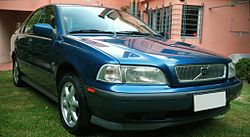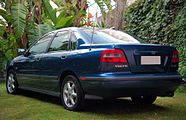Volvo S40 / V40
| Volvo | |
|---|---|
|
Volvo S40 (1995-2000)
|
|
| S40 / V40 (type V) | |
| Production period: | 1995-2004 |
| Class : | Compact class |
| Body versions : | Limousine , station wagon |
| Engines: |
Gasoline engines : 1.6–2.0 liters (77–147 kW) Diesel engines : 1.9 liters (66–85 kW) |
| Length: | 4516 mm |
| Width: | 1716 mm |
| Height: | 1425 mm |
| Wheelbase : | 2562 mm |
| Empty weight : | 1330-1405 kg |
| Previous model |
Volvo 440 , Volvo 460 |
| successor | Volvo S40 / V50 |
| Stars in the Euro NCAP - Crash Test |
|
Volvo S40 / V40 are model names for a series of passenger cars by the Swedish car manufacturer Volvo , which was produced from autumn 1995 to mid-2004.
General
The models S40 and V40 are lower middle class vehicles from Volvo and have replaced the two types 440 and 460 since the beginning of 1996 . The S40 notchback sedan first appeared in September 1995 . The otherwise identical station wagon V40 was introduced in January 1996.
After Volvo had sold shares in the Dutch NedCar to Mitsubishi Motors Corporation , they agreed on a joint project. The Mitsubishi Carisma and Volvo S / V40 were developed on this platform . Both models were produced in the Dutch factory in Born . The 1998 and 2000 Volvo S / V40s were also assembled as CKD kits by the Swedish Motor Corporation in Botswana .
The cooperation with Mitsubishi was ended when the respective model was phased out. The S40 was replaced by the successor of the same name in early 2004. The successor to the V40 followed in spring 2004 and was given the model name Volvo V50
As is typical for Volvo, the S / V40 model series had extensive safety equipment. In addition to front and side airbags, head airbags were also offered from the facelift onwards. The DSA traction control system and an anti-lock braking system were included as standard. When the Euro NCAP crash test was carried out for the first time in 1997, an S40 was the first model ever to receive four stars.
All S40 / V40 had front-wheel drive and a five-speed manual transmission. An automatic transmission was also available on request for certain gasoline engines.
design
The design introduced a new design language at Volvo and was the first model to distance itself from the well-known box shape. The pronounced shoulder line is a feature of the older Volvo models (such as the 240) and should become the new trademark in future model generations.
Facelift
In July 2000, the S40 and V40 received an extensive facelift. The small series from Volvo received revised front and rear aprons which are now rounder. In addition to new rear lights with transparent indicators, clear glass headlights have now also been installed. The interior also received an extensive redesign. With the facelift, the WHIPS whiplash protection system was also integrated into the two front seats of the S / V40.
Engines
The 4-cylinder engines are installed across the front. The petrol engines were developed by Volvo and are based on the "Modular Engine" structure. They supplemented the variants of the well-known 6- and 5-cylinder engines with a 4-cylinder series. The 1.8l GDI direct injection engine with 92KW (125PS) purchased from Mitsubishi is an exception. The direct injection engine was marketed alongside the 1.8 as the 1.8i and was only available with a manual transmission.
The 1.8l and 2.0l naturally aspirated engines and a 1.9l turbodiesel engine from Renault were initially available for the market launch in autumn 1995. In May 1997 the engine range was expanded to include two turbo engines. The T4 with 1.9l displacement and 147 kW (200 PS) was now offered as the top engine. To close the gap to the 2.0l naturally aspirated engine, the 2.0T soft turbo with 118kW (160 hp) came onto the market in the same year.
| model | Displacement | cylinder | power | construction time | comment |
| Gasoline engine | |||||
| 1.6 | 1588 cc | R4 | 77 kW (105 PS) | 09.1995-03.1999 | |
| 1.8 | 1731 cc | R4 | 85 kW (116 hp) | 07.1995-08.1999 | |
| 1.8i | 1834 cc | R4 | 92 kW (125 PS) | 03.1998-07.2000 | GDI |
| 2.0 | 1948 cc | R4 | 103 kW (140 PS) | 07.1996-08.1999 | |
| 2.0 T | 1948 cc | R4 | 118 kW (160 PS) | 10.1997-07.2000 | |
| T 4 | 1948 cc | R4 | 147 kW (200 hp) | 07.2000-06.2004 | |
| diesel | |||||
| 1.9 TD | 1870 cc | R4 | 66 kW (90 PS) | 07.1995-08.1999 | |
The engines were also gradually revised for the facelift. In addition to the basic diesel variant, a slightly more powerful 1.9l engine was added to the model range.
| model | Displacement | cylinder | power | construction time | comment |
| Gasoline engine | |||||
| 1.6 | 1587 cc | R4 | 80 kW (109 PS) | 03.1999-06.2004 | |
| 1.8 | 1783 cc | R4 | 90 kW (122 hp) | 03.1999-06.2004 | |
| 1.8i | 1834 cc | R4 | 90 kW (122 hp) | 06.2001-06.2004 | GDI |
| 2.0 | 1948 cc | R4 | 100 kW (136 hp) | 08.1999-06.2004 | |
| 2.0 T | 1948 cc | R4 | 121 kW (165 hp) | 07.1999-06.2001 | |
| 2.0 T | 1948 cc | R4 | 120 kW (163 hp) | 06.2001-06.2004 | |
| T 4 | 1948 cc | R4 | 147 kW (200 hp) | 07.2000-06.2004 | |
| diesel | |||||
| 1.9 D | 1870 cc | R4 | 70 kW (95 PS) | 03.1999-07.2000 | |
| 1.9 D | 1870 cc | R4 | 75 kW (102 PS) | 07.2000-06.2004 | |
| 1.9 D | 1870 cc | R4 | 85 kW (115 PS) | 07.2000-06.2004 | |
Prices and equipment lines
All prices refer to the sedan S40 in model year 2002. The station wagon V40 cost 1000 EUR more each. An Aisin automatic transmission was only available for the Otto engines at an additional cost of 1,600 EUR.
In the 2002 model year, the following engines were offered in Germany:
- 1.6 l displacement: Otto engine with 80 kW (109 PS), from 19,700 EUR
- 1.8 l displacement: Otto engine with 90 kW (122 PS), from 20,700 EUR
- 1.8 l displacement: Otto engine with 92 kW (125 PS), from 23,950 EUR (only available as Comfort or Sport; type designation 1.8i)
- 2.0 l displacement: Otto engine with 100 kW (136 PS), from 22,100 EUR
- 2.0 l displacement: turbo gasoline engine with 120 kW (163 hp), from 23,600 EUR
- 2.0 l displacement: Turbo gasoline engine with 147 kW (200 PS), from 28,070 EUR (only available as Sport; type designation T4)
- 1.9 l displacement: turbo-diesel engine with 75 kW (102 PS), from 21,100 EUR
- 1.9 l displacement: turbo-diesel engine with 85 kW (115 PS), from 22,100 EUR
With the standardization of the equipment lines within the Volvo Car Group, three different equipment packages were also offered for the V40:
- Basis (without special designation)
- Comfort: surcharge 1550 EUR in model year 2002 (additional: on-board computer, chrome applications outside, interior applications in dark gray, light metal rims, fog lights and textile floor mats, RDS radio with cassette player)
- Sport: surcharge 1800 EUR in model year 2002 (additional: on-board computer, dark-backed clear glass headlights, interior applications in piano black, front and roof spoilers, light metal rims, fog lights and textile floor mats, RDS radio with cassette player)
- X-Sight: Surcharge 1140 EUR in model year 2003 (additionally: xenon headlights with cleaning system, 16 "alloy wheels, 4 × 25-watt RDS radio with cassette as well as subwoofer, side protection strips and bumpers in body color, partial leather upholstery, inlays in wood or in cyborg style, steering wheel and gear lever covered in leather, central locking with remote control and deadlock)
The last model year was sold as a Classic Edition and, in addition to the equipment lines, had upgraded basic equipment.
Market situation
In Germany, the V40 estate models were particularly popular. Due to their low consumption of around 5.4 l per 100 km, the diesel engines installed from July 2000 were in great demand; both engines meet the Euro 3 emissions standard .






